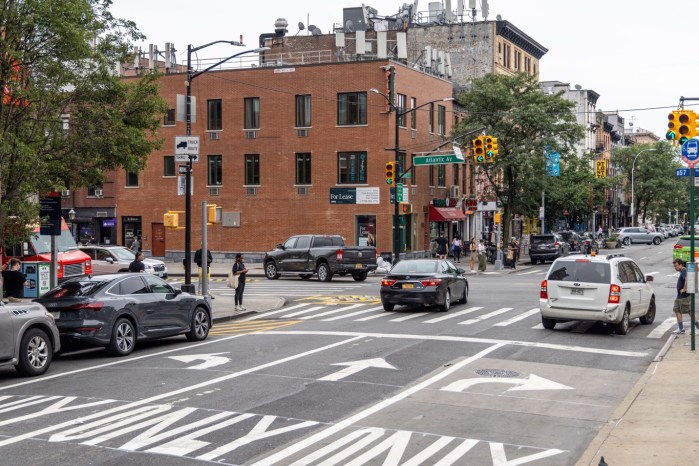This story was originally published on Aug. 30, 2019, by THE CITY.
The city’s jail in Brooklyn will close and the inmates will move to a facility on Rikers Island by around the end of the year, say leaders of the labor unions whose members staff the facility.
The Brooklyn Detention Complex, where 357 male inmates are currently held, will remain empty until demolition begins to make way for a modern new facility, according to two union leaders, who reached out to top department officials for clarification about the plan.
“They are targeting towards the beginning of the new year,” said Patty Ferrioula, president of the Correction Captains’ Association.
The Mayor’s Office of Criminal Justice declined to address the near-term fate of the Brooklyn complex.
“The City is focused on the ULURP process,” said spokesperson Colby Hamilton, referring to the land use review underway to allow for the construction of new borough-based jails, including a new facility where the Brooklyn Detention Complex now stands.
That four-borough proposal is scheduled for a City Planning Commission vote next Tuesday and a City Council hearing next Thursday.
“We are committed to continuing to engage with our government and community partners, as we see this required process for the borough-based jail plan to its end,” added the spokesperson.
According to Ferrioula as well as Joe Russo, who leads the union that represents top jail supervisors, the men in Boerum Hill will be transferred to a facility on Rikers Island where women are currently held. The union officials say they’ve been informed that the 378 women there will be moved to another part of the same building, the Rose M. Singer Center.
The nearly 500 jail officers and supervisors assigned to the Brooklyn facility, located at the corner of Atlantic Avenue and Boerum Place, will be moved to different open spots throughout the department, according to the union officials. A specific date for the closure had not yet been set, they said.
Russo expressed reservations about the pace of the plans.
“They are rushing to close the jail,” said Russo, president of the Assistant Deputy Wardens / Deputy Wardens Association. “The construction plans are not solid or clear.”
‘Stakes in the Ground’
The Brooklyn Detention Complex will be the second facility to close as part of Mayor Bill de Blasio’s plan to shut down the troubled Rikers Island jail complex and replace it with four borough-based jails. Last summer, the Department of Correction closed the George Motchan Center, one of nine buildings on Rikers, citing its serious structural and sewer problems.
In Brooklyn, the city plans to knock down the existing 10-story jail — built in the 1950s and renovated in 2012 — and replace it with a structure rising as high as 395 feet, with room for 1,437 beds. The current site holds a maximum of 736 beds.
The Mayor’s Office of Criminal Justice has yet to seek a construction firm to build the planned new facility, while the land use process to approve the new facilities unfolds.
Supporters of the plan to shut down Rikers are urging the de Blasio administration to take as much action as possible toward completing the new jails before the next mayor takes over.
“The City Council is going to vote, and my point is you have to get the stakes in the ground while the mayor is there,” former Chief Judge Jonathan Lippman, who led the panel that called for the closing of Rikers, said during an interview earlier this month.
Some elected officials, including Brooklyn Borough President Eric Adams, want significantly smaller facilities than those the proposed land use plan would allow, as well as yoga and plant-based food options in the jail.
De Blasio administration officials have said they expect to ultimately reduce the proposed size of the four planned borough-based jails due to a steeper-than-anticipated drop in the inmate population.
The mayor’s plan is intended to ultimately bring inmates into closer proximity to courts and visitors than they are on remote Rikers Island. In the meantime, pointed out Elias Husamudeen, president of the Correction Officers’ Benevolent Association, the number of inmates on Rikers will go up before the new jails are completed — an outcome he did not object to.
“COBA is more focused on achieving safer jails than the location of a jail, and that should be the city’s focus as well,” Husamudeen said.
Mayor Michael Bloomberg’s administration closed the Brooklyn jail in 2003 after the inmate population shrunk. Nine years later, the facility reopened, in part to make it easier to transport inmates to court hearings in Brooklyn and Staten Island.
It has been one of the most dangerous lockups in the department over the past several years. Records show 58 stabbings and slashings at the Brooklyn Detention Complex from 2015 to 2018. Yet the facility only had one during the six years prior to 2015.
On Thursday, a former Brooklyn detainee, Christopher Lyles, sued the city and Department of Correction in Kings County Supreme Court for injuries he alleges he sustained in a stabbing by a fellow inmate in February.
This story was originally published by THE CITY, an independent, nonprofit news organization dedicated to hard-hitting reporting that serves the people of New York.























